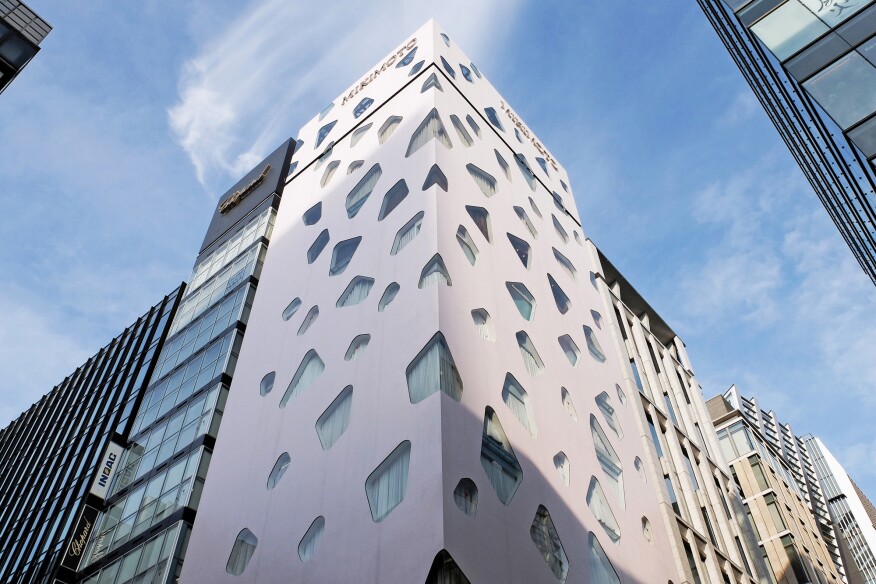
Japanese contemporary architecture is often admired for its simplicity, attention to detail, contemplative atmosphere, and palpable emphasis of material lightness and/or gravity (see my recent article “Learning from the 'Red' and 'White' Schools of Japanese Architecture”). Though these characteristics are indeed common among recent projects designed by Japanese architects, they fail to address a quality that is fundamental to understanding these works.
This quality is embodied in the Japanese concept of ihyou (pronounced “ee-hyoh”), meaning something unexpected or surprising. Ihyou is a unifying force in Japanese architecture today and a primary aspiration of its designers. Regardless of project type, scale, or material character, they believe that a building must shift our expectations—and by doing so, reveal the broader possibilities of experience within the physical environment.
Although there are many types of surprises, from subtle to abrupt, architectural ihyou is rarely shocking or gratuitous. Rather, it awakens the mind of the user without causing alarm, sparking curiosity, intrigue, and delight. The goal of ihyou is to make a conscious connection in order to impart an indelible memory. Three primary strategies for achieving ihyou can be described by what the designers seek to convey: impossibility, incongruity, and totality.
Impossibility
Practitioners often invoke Tadao Ando, Hon. FAIA’s name in relation to the pursuit of material perfection, particularly in reinforced concrete construction. They also appreciate his work’s compelling manipulation of light and shadow, processional sequences, and interlocking platonic volumes. His projects should also be recognized for their purposeful intimations of defying gravity.

For example, an exterior courtyard at Ando’s Chichu Art Museum, in Naoshima, Japan, is surrounded by a concrete enclosure that appears to hover above a horizontal void, lacking any means of vertical load transfer. The ceiling of an underground space in his Ando Museum, also in Naoshima, consists of a backlit concrete disc with no sign of attachment. His renowned Church of the Light, in Ibaraki, Japan, is memorable not only for its crucifix-shaped aperture but also for its lack of visible supports for the concrete planes that frame the wall’s upper quadrants.

The work of Kengo Kuma, Hon. FAIA, also appears to challenge the laws of physics. His Lotus House, in eastern Japan, is sheathed in a checkerboard curtain of travertine. The clever use of inconspicuous steel supports makes the stone seem to float in midair. Kuma’s Chokkura Plaza, in Tochigi, Japan, employs chevron-shaped Oya stone blocks—also with hidden steel reinforcing—in an open arrangement that appears to defy the vertical load-bearing logic of the masonry wall.
Incongruity
Along with “impossible” details, Japanese contemporary architecture regularly undermines conventional expectations at a macro level. One method concerns the development of structural expressions that are out of keeping with established practices. Toyo Ito, Hon. FAIA’s Mikimoto Ginza 2 building, in Tokyo, exhibits a hybrid reinforced-concrete-and-steel-plate enclosure that lacks visible control joints. A collection of apertures placed at seemingly random intervals—and at building corners—disguises what is effectively an internal diagrid structure. The result is a curious absence of vertical continuity, distinct floor levels, and construction joints—three tectonic indicators common to buildings.


Another approach is to seek unexpected relationships between a building’s programmed use and its anticipated physical arrangement. For example, SANAA’s Grace Farms, the recent recipient of the 2014/2015 Mies Crown Hall Americas Prize (MCHAP), arranges a variety of modestly sized programs within an undulating site. Rather than house them in separate buildings at different elevations, the architects united the functions within a singular structure that traverses the site topography.
In contrast, Ryue Nishizawa’s Moriyama House, in Tokyo, deconstructs the typical private residence, treating individual rooms as separate structures that are deployed across the site.

Totality
Many Japanese architects seek to make an indelible impression by way of an all-encompassing experience. This totalizing treats buildings more like landscapes: Foreground is merged with background, and the enclosed volume’s delimitations are unclear. For example, SANAA’s Rolex Learning Center, in Lausanne, Switzerland, combines multiple functions within a single outsized floor plate that rises and falls like rolling terrain. Junya Ishigami’s Kanagawa Institute of Technology Workshop is similarly treated as a single volume, supported by a forest of thin, irregularly spaced columns. Tokujin Yoshioka’s Lexus L-Finesse installation consists of thousands of suspended transparent fibers, immersing visitors in a cloud.

Totalization is typically accomplished with a focus on a single material system. A severely reduced palette enables architects to maximize the sensory impact of the experience. SANAA’s Glass Pavilion at the Toledo Art Museum appropriately prioritizes the use of floor-to-ceiling glass walls. Collectively, the layers of curved glass manipulate light in unpredictable ways. Kuma’s Sunny Hills store, in Tokyo, is enveloped in a deep lattice of thin timber slats that mimic a bamboo basket. Sou Fujimoto has also emphasized singular material strategies in his 2013 Serpentine Gallery Pavilion, in London, with its immersive steel microstructure, and his 2016 Naoshima Pavilion, composed of triangulated steel mesh.

A Common Aim
These three strategies—impossibility, incongruity, and totality—demonstrate the near-universal pursuit of ihyou among contemporary Japanese architects. Although the approaches can vary widely, evoking the unexpected is a common theme. Upon looking closely at these works, you may begin seeing ihyou everywhere. Certainly, architects worldwide similarly seek to surprise and delight. However, one reason Japanese architects have recently drawn so much admiration concerns their unparalleled perseverance in realizing their conceptual visions.
Accomplishing ihyou requires both fearlessness and rigor: a confidence to make risky proposals combined with a meticulousness to ensure their successful execution. By seeking to make the uncommon common, Japanese architects continually help us experience the world anew.
















